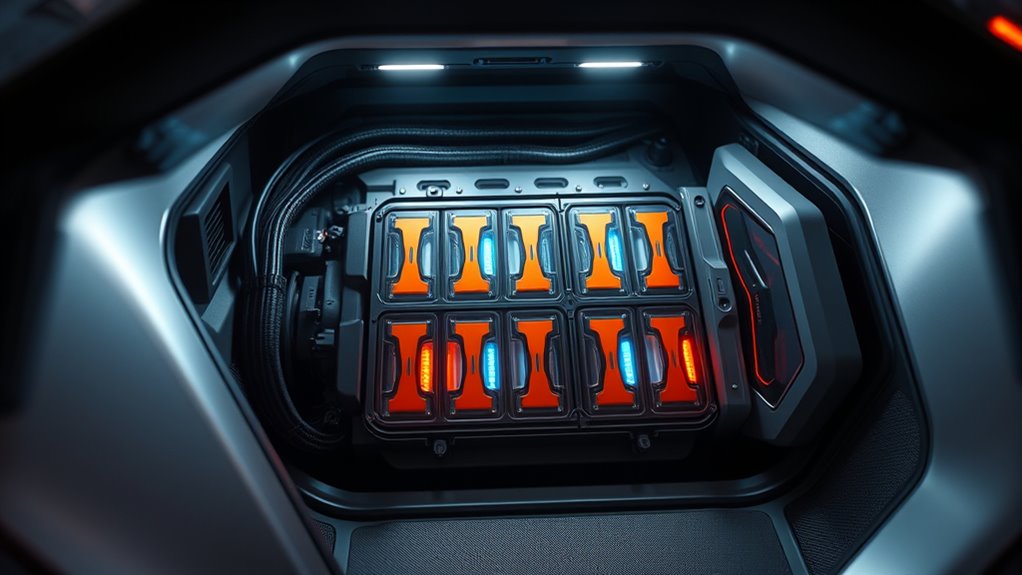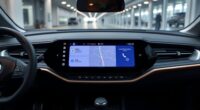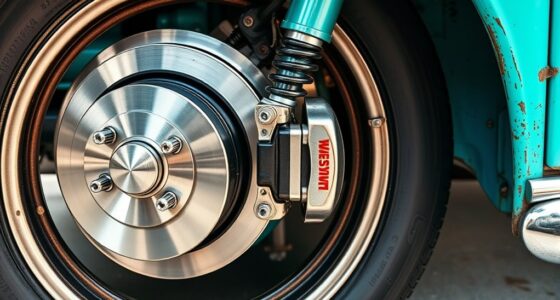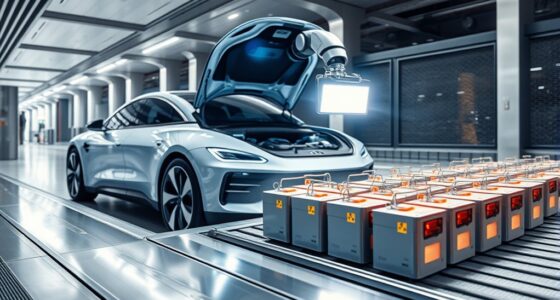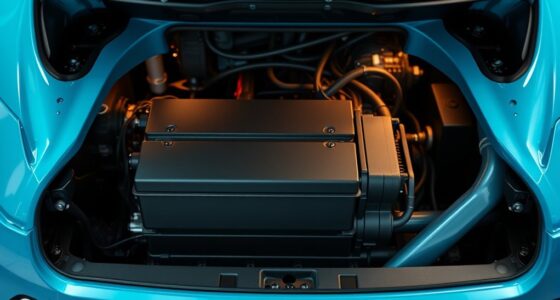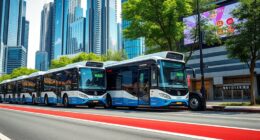The ID.Buzz features a high-capacity lithium-ion pouch cell battery pack with advanced thermal management for safe, fast charging up to 200 kW, ensuring minimal downtime. It offers around 86 kWh of usable energy, supporting a range of approximately 180–230 miles depending on driving conditions. The battery is designed for durability, with smart cooling systems maintaining ideal temperatures to extend lifespan. If you want to discover more about its chemistry, maintenance, and performance tips, keep exploring these details.
Key Takeaways
- The ID.Buzz uses a lithium-ion pouch cell prismatic battery with advanced chemistry for high energy density and safety.
- It features liquid-cooled thermal management supporting fast charging up to 200 kW.
- The battery has an 86 kWh usable capacity, providing a WLTP range of approximately 261 miles.
- Designed for durability with an 8-year warranty, it includes modular construction for easy maintenance.
- The high-voltage system (likely 400V) ensures efficient power delivery and optimized vehicle performance.
Overview of the ID.Buzz Battery Pack
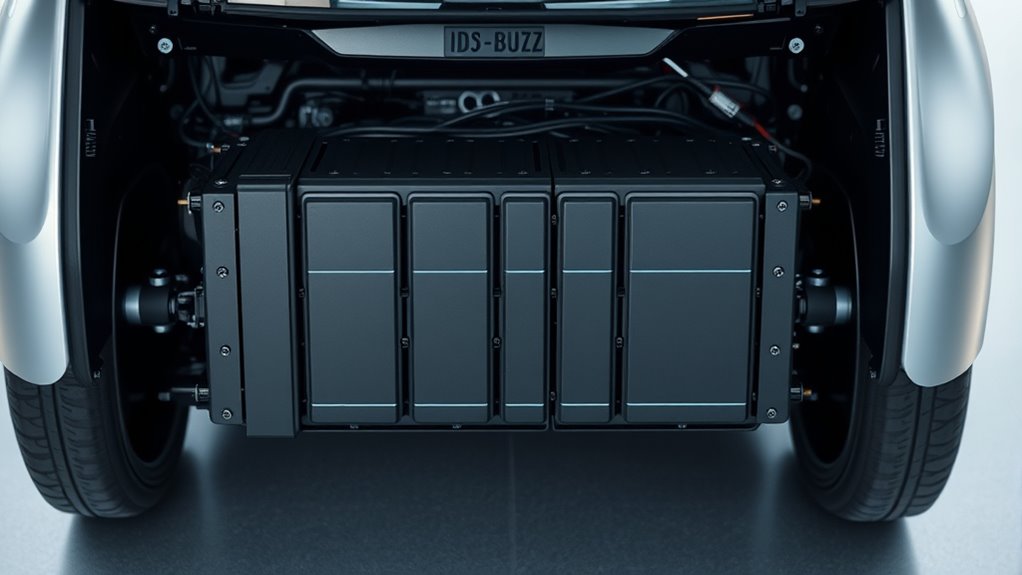
The ID.Buzz features a high-capacity lithium-ion battery pack with a usable capacity of 86 kWh and a gross capacity of 91 kWh, providing ample power for both rear-wheel-drive and all-wheel-drive versions. This battery is composed of pouch cell prismatic technology, arranged in modules with a typical configuration like 96s3p. It has a nominal voltage optimized for the vehicle’s electrical system, ensuring efficient performance. The pack’s design supports fast charging, capable of reaching 80% charge in about 30 minutes with a DC fast charger. Weighing approximately 489 kg and measuring around 142 x 145 x 14 cm, the battery’s modular design balances energy storage with space and weight considerations. Its high energy density contributes to the vehicle’s impressive range and overall efficiency. The battery management system plays a crucial role in maintaining optimal performance and longevity of the battery pack, ensuring safety and reliability over time. Additionally, advancements in battery technology are driving improvements in energy density and charging capabilities, further enhancing vehicle performance. Furthermore, ongoing research into cell chemistry aims to develop batteries with longer lifespans and greater safety margins, which could benefit future models.
Battery Technology and Chemistry

Battery technology in the ID.Buzz relies on advanced lithium-ion chemistry combined with liquid-cooled thermal management to maximize performance and longevity. The battery pack features an 86 kWh net capacity, with a 91 kWh gross capacity that includes a buffer, enhancing durability.
Its floor-mounted design ensures better weight distribution and safety, while the high-voltage architecture, likely 400V, supports efficient power delivery. The modular, standardized cell format shares technology with the ID.4 and Audi Q4 e-tron, allowing scalability.
Liquid cooling maintains ideal battery temperature, improving efficiency and fast-charging capabilities up to 200 kW. This setup also helps mitigate degradation, prolonging battery life.
Designed with safety and durability in mind, the system aims for a long service life, typically backed by an 8-year warranty.
Charging Capabilities and Speeds
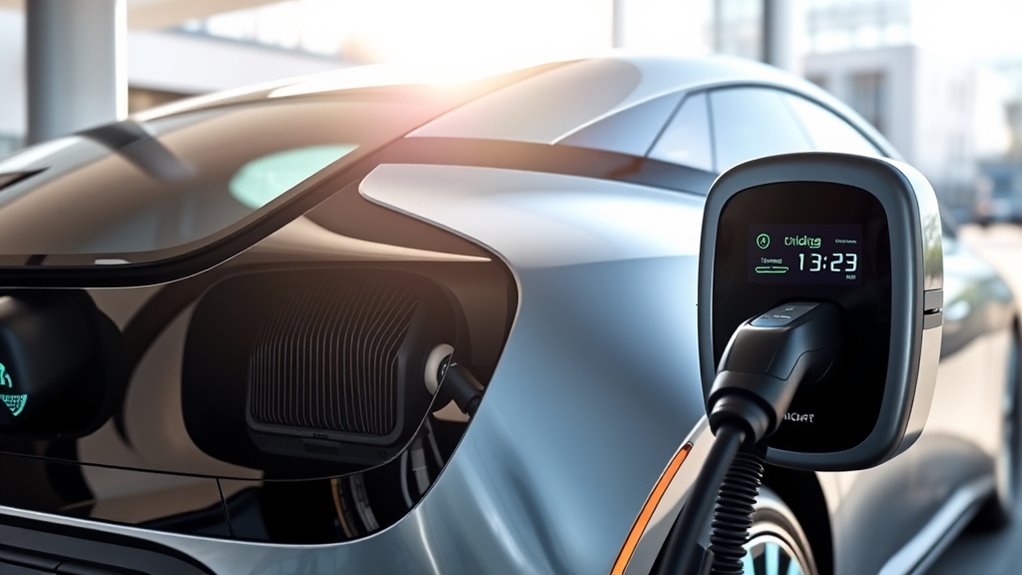
Charging capabilities in the ID.Buzz vary markedly depending on the method used, allowing flexibility for different driving needs. Using a standard wall plug delivers just 11 km per hour, taking over 39 hours for a full charge—best only in emergencies. A 1-phase 16A charger provides 17 km/h, suitable for overnight charging, while a 32A setup offers 35 km/h, ideal for daily partial top-ups. For faster charging, a 3-phase 16A connection delivers 51 km/h, making it perfect for quick top-offs. DC fast charging with CCS enables up to 175 kW, reducing charging to around 30 minutes for most of the battery. Public stations and home chargers support various configurations, but the vehicle’s limits mean maximum efficiency occurs at 11 kW AC. Charging efficiency can be affected by factors such as temperature and battery age, impacting overall performance. Cold weather and battery age can also impact charging speeds. Additionally, heat pump efficiency can influence the vehicle’s energy consumption during operation, especially in colder climates. Proper thermal management is essential for maintaining optimal battery health and charging performance over time, particularly because the battery’s charging system interacts with the vehicle’s electronic components to optimize power transfer.
Range and Efficiency Metrics
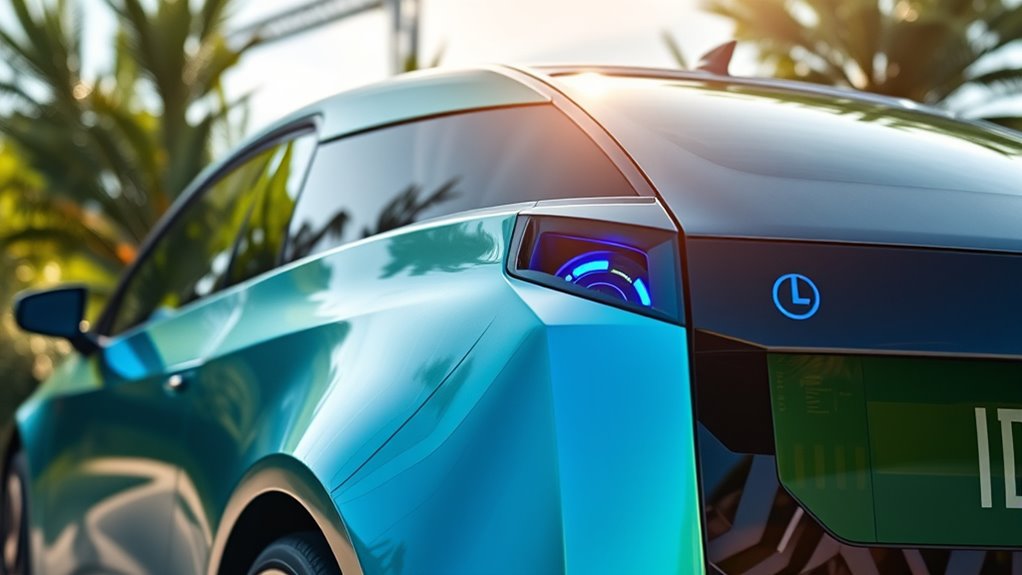
Understanding the range and efficiency of the ID.Buzz helps you gauge how far you can go on a single charge and how driving habits affect performance. The WLTP range for the ID.Buzz Pro is about 261 miles with an 82 kWh battery, but real-world tests typically show 180 to 210 miles. EPA estimates differ slightly: around 234 miles for single-motor versions and 231 miles for dual-motor setups. On highway tests at 75 mph, expect roughly 190 miles. Efficiency drops with higher speeds; at 81 mph, energy consumption can reach 2.1 mi/kWh. Urban driving maintains better efficiency, while weight and aerodynamics impact overall performance. Managing speed and conditions helps maximize your range, but long trips require careful planning. Cookies used to enhance browsing experience can also influence how data is collected to improve vehicle performance and user insights. Additionally, understanding asset division laws can be crucial if planning for future asset management. Factors like battery degradation over time can also affect the vehicle’s range, so regular maintenance is recommended.
Performance of the Electric Drive System
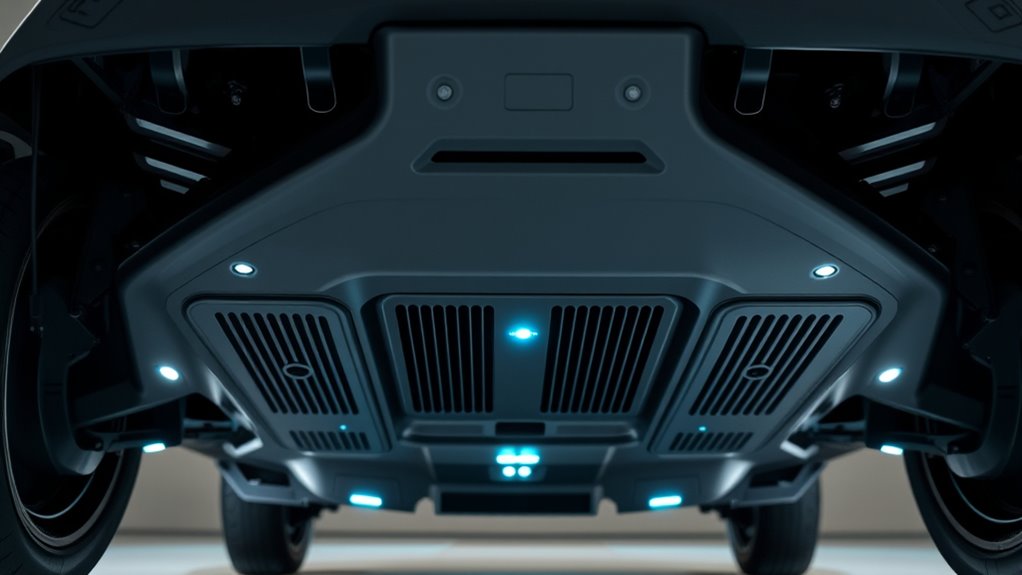
The ID.Buzz’s electric drive system delivers impressive performance through its well-engineered powertrain configurations. With a single-motor RWD setup producing 282 hp and hitting 0-60 mph in 6.7 seconds, you’ll notice quick acceleration. The system also benefits from advanced performance tuning techniques that optimize power delivery and efficiency. Essential oils for toothache relief such as clove oil and peppermint oil are often used to manage oral discomfort, illustrating how natural solutions can complement modern technology. The system’s market adaptability ensures it remains competitive as EV technology evolves, allowing for continuous improvements and updates. The inclusion of Ford Tuning methodologies can further enhance system responsiveness and energy management. Opt for the dual-motor AWD, which delivers 335 hp and achieves 0-60 mph in just 5.5 seconds, providing sharp mid-range responsiveness thanks to instant torque. The system offers smooth, linear power delivery with minimal wheelspin, thanks to traction control optimization. Its permanent magnet synchronous motors focus on efficiency, while regenerative braking enhances energy recovery. Handling is balanced, with accurate steering and a comfortable suspension tuned for minimal body roll. Top speeds are electronically limited to 90 mph, but acceleration remains strong for everyday driving and passing maneuvers.
Practical Considerations for Battery Use
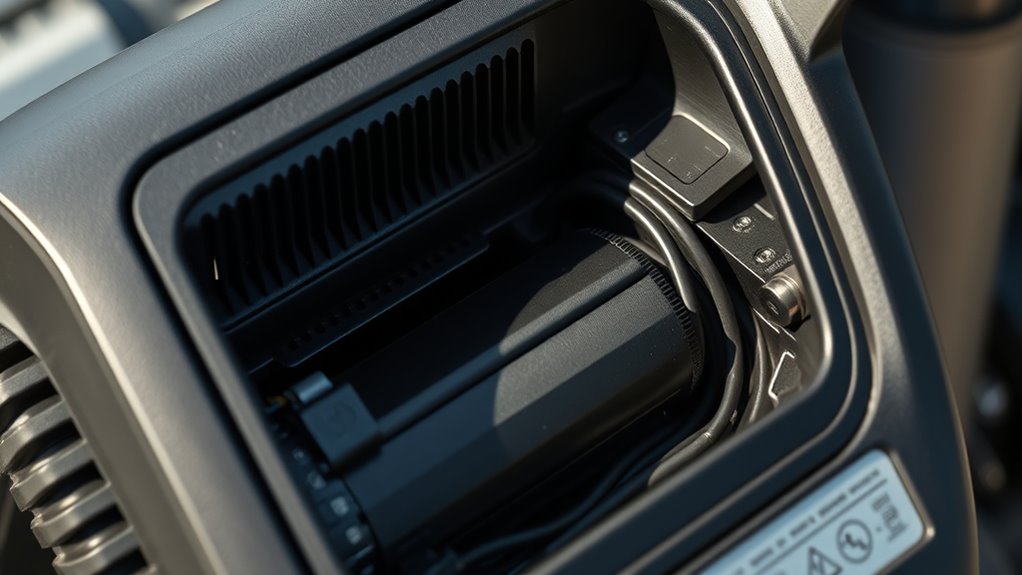
When using the ID.Buzz, you’ll find that its battery performance depends heavily on real-world factors like driving habits, weather conditions, and load. Cold weather reduces range because batteries become less efficient, making trips longer and more challenging. Empowering families can help improve understanding of how to optimize vehicle use in various conditions. Speeding and carrying heavy loads on the highway also cut into your mileage. On long trips, frequent charging is necessary, but charging stations can be unreliable or incompatible, requiring careful planning. The 12V battery is vulnerable and can strand you if it dies unexpectedly, especially in cold climates. For daily use, installing a Level 2 home charger is recommended. Keep in mind that fast-charging accelerates battery degradation, and early signs of high battery wear may occur. Monitoring tools are limited, so staying alert to vehicle alerts helps prevent surprises. Additionally, understanding the importance of proper battery maintenance can extend the lifespan and performance of your vehicle’s battery system. Recognizing how battery efficiency varies with conditions can also help you plan optimal charging and usage strategies.
Frequently Asked Questions
How Does Battery Age Affect Vehicle Performance Over Time?
Over time, battery age causes your vehicle’s performance to decline. You’ll notice reduced acceleration, slower regenerative braking, and less power during driving.
As the battery’s internal resistance increases, it struggles to deliver peak power, especially in extreme temperatures. Frequent fast charging and aggressive driving speed up this process.
To keep your vehicle performing well, avoid deep discharges, maintain moderate temperatures, and follow good charging habits.
What Are the Optimal Charging Practices to Prolong Battery Lifespan?
To prolong your battery’s lifespan, you should follow best charging practices. Keep daily charges around 80% to reduce stress, and only fully charge before long trips.
Avoid frequent fast DC charging, which speeds up capacity loss. Use regular AC charging at ≤11 kW, and maintain the battery between 30-80% if unused for a while.
Also, park in shade and avoid deep discharges to minimize thermal and chemical stress.
Can the Battery Be Replaced or Upgraded in the ID.Buzz?
Imagine your ID.Buzz’s battery degrades over time, and you’re wondering if you can replace or upgrade it. Currently, you can replace the battery, especially if it drops below 70% capacity within warranty.
Upgrades are limited and often require technical modifications. While future models might offer larger batteries, upgrades in existing vehicles aren’t straightforward.
Regular maintenance and warranty coverage help extend your battery’s life.
How Does Temperature Influence the Battery’S Efficiency and Charging?
Temperature greatly influences your battery’s efficiency and charging. Cold weather thickens the electrolyte, slows chemical reactions, and increases energy use, reducing range.
Charging in cold conditions is less efficient unless the battery is warm, and extreme heat accelerates battery aging.
To optimize performance, precondition your vehicle, charge when warm, and keep software updated.
What Safety Features Protect the Battery During Accidents?
Imagine a vehicle in a crash, where chaos and safety coexist. You’re protected by the ID.Buzz’s safety features that guard its battery.
The high-voltage system automatically shuts down, preventing sparks or fires. Thermal monitoring keeps the battery cool, while impact-resistant design shields it from damage.
Emergency disconnects and rescue access guarantee quick response. These measures work together to keep you safe, even in the worst accidents.
Conclusion
Knowing that the ID.Buzz’s battery offers up to 370 miles of range on a single charge, you can confidently plan longer journeys without constant stops. Its fast-charging capability can get you back on the road in just 30 minutes, making electric travel more practical than ever. With cutting-edge chemistry and efficient design, you’ll enjoy reliable performance and peace of mind, knowing your vehicle’s battery is built for both adventure and everyday use.
